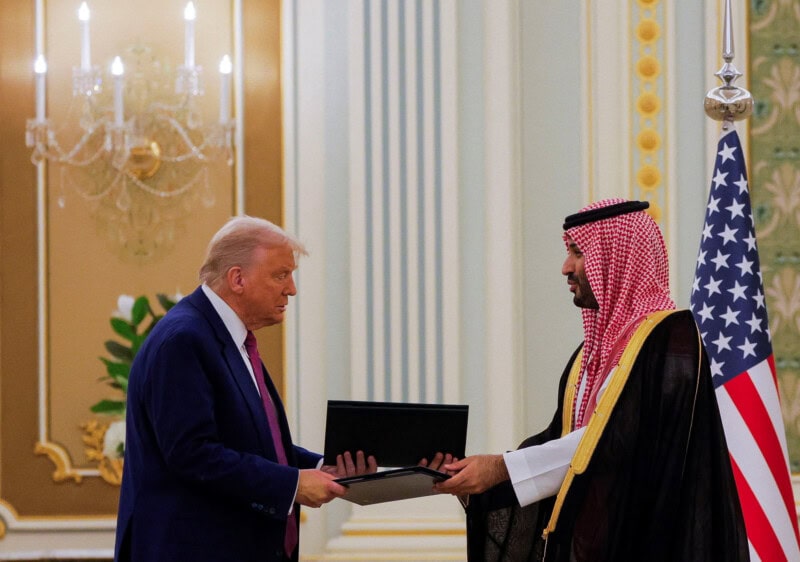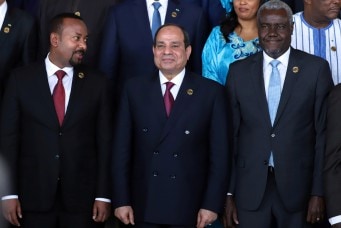Great Power Competition Makes Its Exit as Middle Eastern AI Ambitions Grow
As the Trump Administration downgrades the policy importance of science and technology, Middle Eastern states are pursuing tech autonomy

The Middle East has become a regional flashpoint in the technology competition between the United States and China. This is unsurprising: many states within the region are intent on throwing their capital behind long-term technological ambitions and are amenable to some degree of collaboration with others, making them of interest to the great powers who seek a commanding lead over the technological foundations of power. The domain of artificial intelligence (AI) is no exception; tussling over the orientation of states like the United Arab Emirates (UAE) and Saudi Arabia is now taken for granted. Great power competition has been the framework de jour of foreign policy analysts.
American presidential administrations from the late-Obama administration, through the first Trump administration, and up to the Biden administration devoted increasing resources to the objective of shoring up the United States’ leadership in AI and its Middle Eastern partnerships. The latter has concentrated disproportionately in the Gulf, maturing significantly since the Generative AI boom of 2023.
Under the Trump administration, however, great power competition as a driver of American policy is sharply reversing. The framework is inadequate for explaining the United States’ most recent changes regarding the pursuit of science and technology, indicating a downgrading of the importance of America’s great power competition with China. This shift has important implications for AI and related Middle Eastern technology ambitions.
The upshot of this shift for the Middle East is as follows: the diminishment of basic and applied scientific research as a U.S. policy priority will accelerate Gulf states’ efforts to construct viable, indigenous, and autonomous AI industries and related technology ecosystems.
That being said, there will be no sharp decoupling of U.S.-Middle East technology cooperation. Nor does the United States’ shifting stance toward technology competition indicate a broader realignment of its Middle East relationships. Instead, the focus of Gulf states (in particular) will turn to accelerating their existing trend toward technological autonomy, potentially contracting the scope of cooperation with the United States in the medium- and long-term. Gulf states will likewise seek to shrink the timeline of their existing arrangements with the U.S. technology industry. Consistent with political scientist Stacie Goddard’s argument, President Trump’s inclination toward transactional dealmaking might be a break from great power competition, but that does not mean a break from foreign engagement.
Finally, this argument is not normative; it makes no claims about whether the United States should be undergoing this shift or whether Gulf states should accelerate their timelines.
This article begins with an assessment of Gulf states’ efforts to make inroads in the American AI and broader technology ecosystem, showing how these have intertwined with the U.S.-China competition. Then, we turn to America’s abrupt pivot away from this competition and the science and technology policies constructed to serve it. The article concludes with a projection of how Middle Eastern AI ambitions will (and will not) be impacted by America’s pivot.
Great Powers in the Gulf
The Middle East’s AI ambitions are disproportionately concentrated in the Gulf and, more specifically, in the UAE and Saudi Arabia. Part of this owes to these states’ capital-rich coffers, with sovereign wealth funds and investment vehicles oriented towards diversifying their sources of economic growth and development. As political economist Robert Mogielnicki details, the Gulf has been trending toward emerging technology investments and forums for some time. Gulf sovereign wealth funds have focused on digitization as a means of economic diversification and domestic development initiatives. Though less-resourced, Oman, Bahrain, Qatar, and Kuwait are also acting to invest in burgeoning technologies.
That said, capital alone is insufficient to explain the inroads made in AI and related emerging technologies. The UAE and Saudi Arabia also established national AI and data strategies that seek to deploy resources to indigenous technology ecosystem build outs and construct policies suitable to the attraction of foreign talent (the former as far back as 2017).
Saudi Arabia, for its part, has made inroads in the American technology industry as well. In March 2024, the Saudi Public Investment Fund (PIF) was reportedly in talks with U.S.-based venture capital fund Andreessen Horowitz to establish a $40 billion fund to invest in AI, with talks continuing into at least late-2024. Additionally, the PIF entered into a strategic partnership with Google in October 2024, sharing plans for a new AI hub located near Dammam. Saudi-based oil producer Aramco also partnered with California-based AI semiconductor startup Groq in September 2024 to construct the world’s largest AI inferencing data center to support the large-scale deployment of AI models. The partnership expanded in December 2024.
These ambitions have been accompanied by a slew of additional investments and milestones by Gulf states, which intertwine with the broader U.S.-China technology competition. The UAE’s state-backed AI conglomerate G42 took center-stage in this competition during the swelling of geopolitical interest in AI in 2023. The reason: G42 began making quick and high-profile forays into both the AI sector and the American technology industry. One such engagement was a December 2023 announcement that G42 partnered with OpenAI to leverage the latter’s AI models in financial services, energy, healthcare, and public services.
American officials noticed. The United States has approached its AI competition with China through the framework of ‘compute governance’, which aims to restrict China’s AI development by preventing it from purchasing certain pieces of necessary hardware. One way to restrict this access is to ensure that foreign nations collaborating with U.S. companies agree not to sell the hardware they have purchased to China, a process called ‘export controls’.
Concerned with the threat of advanced technology loss from companies like OpenAI to China (in part through this arrangement with G42), then-chairman of the U.S. House Select Committee on the Chinese Communist Party Rep. Mike Gallagher wrote a letter to then-Secretary of Commerce Gina Raimondo to investigate the risks G42 poses to the export of American technology in January 2024. The letter was explicitly concerned with G42 CEO Peng Xiao’s ties to Chinese companies.
Less well-known is that United States Bureau of Industry and Security (BIS) officials (located within the Department of Commerce) had already met with Xiao and other G42 representatives in the Summer of 2023. BIS communicated that G42 had to side with the United States or China and make their investments appropriately. By February 2024, G42 had divested from Chinese holdings, making efforts to cut Chinese companies from its supply chain, indicating a hardening U.S. orientation by the company.
Fast forward to April 2024, when Microsoft announced a $1.5 billion investment in G42, granting it a minority stake and a board seat. The Microsoft-G42 partnership was the result of government-to-government negotiations and assurances concerning the security of advanced technology exchange between the firms. In March 2025, building on this progress, the UAE Department of Government Enablement announced a multi-year agreement between Microsoft and the G42 company Core42 to create a unified, sovereign cloud system for government services.
More recently, the UAE’s AI investment vehicle MGX is participating as a partner in the “Stargate” data center project worth up to $500 billion, jointly formed by OpenAI, Oracle, and Softbank. The project was announced on January 21, 2025, directly following U.S. President Trump’s inauguration. (Reporting in May 2025 indicates that OpenAI is seeking to expand its Stargate data center project abroad, though to which state(s) is unclear.)
Merits of the project notwithstanding, Stargate could reasonably be interpreted as the second Trump administration’s intention to continue the American pivot towards emerging technology, principally focusing on AI as the crown jewel of twenty-first-century power. This interpretation was, nevertheless, premature, and U.S. policymaking has since broken from this trend.
American Scientific Disengagement
At first glance, rhetoric from the second Trump administration recognizes the urgency of technological competition. In his remarks at the AI Action Summit in Paris in February 2025, Vice President J.D. Vance made four points clear, one of which is that American AI technology will continue to serve as the global “gold standard”. Similarly, the White House published an open letter to the newly confirmed Office of Science and Technology Policy (OSTP) Director Michael Kratsios on the utter importance of scientific progress and technological innovation, tasking him with the maintenance of “unrivaled” American leadership in critical and emerging technologies like AI.
Yet, actual federal policymaking paints a different picture. Early funding-related actions portended a shift in the priorities of the U.S. government.
A memo put out by the White House Office of Management and Budget in the second week of the new Trump administration ordered federal agencies “to temporarily pause all activities related to obligations or disbursement of all Federal financial assistance”. The ensuing chaos caused by the extraordinarily broad directive (such assistance, interpreted literally, amounts to several trillion dollars) was seen as a temporary speed bump; a bureaucratic error.
This interpretation was reasonable, but that same week, the administration released a “buyout” offer to all federal employees (voluntary separation with a promise of time-bound extension of compensation). Still, however, this could be interpreted as a shift in the composition of the U.S. federal government (fewer employees and leaner, more efficient staffing).
This interpretation also breaks down in the immediate aftermath of these actions, with the upending of the country’s scientific research apparatus. In early February, the National Science Foundation (NSF)—a critical component of U.S. technological leadership—shared plans internally to cut between one-quarter and half of its staff over two months. In April 2025, NSF Director Sethuraman Panchanathan—appointed by President Trump in his first term—resigned from the agency (well before his term was up) amid severe funding cut directives from the Department of Government Efficiency (DOGE). Days later, in early May, the NSF staff were told to “stop awarding all funding actions until further notice”. Then, that same week, President Trump’s proposed Fiscal Year 2026 budget requested a 56% funding reduction for the NSF. (Note that the U.S. Congress, not the Executive Branch, determines federal agency budgets; the president’s request is not final.)
Taken together, a picture begins to emerge not of a different approach to U.S. technology primacy, but a re-prioritization of science and technology policy altogether.
A critic might point to a continuation of the current funding levels for specific technological initiatives, including those that are AI-related, as evidence that these have retained their importance in policymaking (though not keeping up with inflation).
This is a significant piece of evidence, though a suitable interpretation is not that the administration has retained the great power technology competition framework of previous administrations. Rather, it indicates that some level of diversity of opinion exists among U.S. officials and policymakers.
Indeed, a strong piece of evidence indicating a shift away from great power competition is the disinterest of U.S. officials in retaining scientists in the United States, including at agencies like the NSF. The disruptions described so far have led some European universities, particularly in states like France, Belgium, and the Netherlands, to establish programs for American scientists looking to flee cuts to research. European Commission President Ursula von der Leyen also announced a $556 million investment to pull in researchers from the United States in May (the impact of this relatively small investment should not be exaggerated, though its purpose is clear).
Some U.S.-based researchers hold long-term concerns over the viability of scientific research in America, given the perceived political bent of the recent disruptions. According to polling released by Nature in March, among 1,608 researchers, more than 1,200 answered “yes” to a question asking if they are considering leaving the United States due to Trump-induced science disruptions.
Not to be outdone by Europe, Chinese actors have made their own overtures to American scientists. An advertisement was put out by a Shenzhen-based tech recruiter in February targeting scientists laid off from U.S. federal agencies. The ad appeals to “talents who have been dismissed” by U.S. agencies. This occurs just as Chinese startup DeepSeek enjoys the momentum generated by its V3 and R1 models (the latter is taken to be a direct competitor of OpenAI’s ‘o-series’ models). As of March, recent graduates from top U.S. schools like Stanford and Harvard are flooding DeepSeek with resumes.
If technological supremacy as a pillar of United States policy still reigned supreme, these foreign actions would be met with counterbalancing policies by the U.S. government to mitigate or prevent such losses (or even the prospect of losses). Yet, these counterbalancing policies are not in evidence. Moreover, if the interpretation that U.S. policymaking is guided by different priorities than those associated with great power competition is accurate, then we should be able to identify a range of actions consistent with these new priorities across federal agencies (the NSF, in principle, could merely be an aberration).
The story is much the same across the federal scientific research apparatus. Also in early February, the Trump administration announced an intention to limit “indirect funding” distributed by the National Institutes of Health (NIH) to laboratories nationwide. A series of lawsuits related to these cuts followed in quick succession. Undeterred, by late March, the Department of Health and Human Services, which oversees the NIH, announced plans to cut 20,000 full-time jobs (including some employees who accepted the “buyout”), aiming for a force reduction from 82,000 to 62,000 employees. An initial layoff of 10,000 employees began in April.
Since these early actions, a sense of “chaos and confusion” has ruled over agencies like the NIH. DOGE directives to ban all outgoing communications and to cease submitting research to journals chilled the agency. Although some rules and layoffs have been reversed, senior staff reportedly are left with a sense of insecurity. (Even beyond scientific research, traditionally secure recipients of (limited) funding, like the Department of Defense’s future-planning Office of Net Assessment, were scheduled for “disestablishment”.)
Some academics in the United States remain forward-looking, though it is now common to find flagship publications like Science refer to these policy actions as those that “wreaked havoc in American universities and…threaten the global scientific enterprise”.
Such policy actions are not best interpreted as irrational means of pursuing American technological leadership. Instead, they are consistent with a policy approach that is not driven by the demands of urgent technological competition with China to prevent the latter’s re-shaping of world order. The rhetoric we noted above, in this case, does not reflect the in-practice orientation of the U.S. government. In this way, the actions are rational; they merely reflect different priorities. This shift will impact Middle Eastern AI (and broader technological) ambitions over the medium- and long-term in ways that reflect their existing interests.
Accelerating the Bid for Autonomy in the Middle East
Importantly, significant changes to U.S.-Middle Eastern technology dynamics will likely be visible over the medium- and long-term rather than the short-term. There are two reasons for this. First, the Trump administration may continue an aggressive approach to the export of advanced semiconductors and/or AI models to other states, depending on its replacement policy for Biden-era regulations. This simply means that the flow of hardware, AI models, and/or computing capacity to other countries may continue to be restricted according to some set of regulations established by the U.S. government and therefore require significant diplomatic engagement to navigate them. Second, the commercial partnerships already formed between the United States and Gulf states have staying power and cannot be readily reversed.
Regarding the first point, a visit by Emirati National Security Advisor Sheikh Tahnoon bin Zayed Al Nahyan in March 2025 with President Trump is relevant, as AI was at the top of the agenda. The Microsoft-G42 partnership described above has allowed the UAE to garner increasing access to advanced chips, including Washington’s approval of the sale of H100 AI chips designed by Nvidia, which enable the development and deployment of advanced AI models.
It is within the Emirates’ interest (and the interest of any state with AI ambitions) to retain or expand such access. Thus, as technology and geopolitics researcher Mohammed Soliman notes: Tahnoon may have tried to “balance between the security concerns of the United States but at the same time not to cap [the UAE’s chip imports] when it comes to how many chips they can access in a way that hammers [sic] their own ambitions.”
Indeed, limited early signals indicate a continuation of the outsized role played by U.S.-led export controls in Gulf states’ AI ambitions. Both Sheikh Tahnoon’s visit to the White House and the addition of entities to the United States’ export control blacklist indicate the UAE’s (and likely broader Gulf’s) interest in balancing U.S. interests with their own. Access to advanced enabling hardware in sufficient amounts and within suitable timeframes will continue to drive relations.
Regarding the second point, the commercial investments and partnerships that Gulf states have formed—Microsoft-G42, Groq-Aramco, Stargate, etc.—represent sunk costs and they hold staying power. Such actions represent years of financial and diplomatic investment, complete with the relocation or establishment of talent and facilities relevant to AI development or deployment. These costs cannot simply be shifted, even if the United States’ current loss of scientific talent continues. Additionally, they have staying power because the United States’ commercial AI ecosystem remains, at least for now, the most dynamic in the world with access to the most sophisticated models, hardware, and talent. It would not be within Gulf states’ interests, therefore, to summarily switch sides, even if this were possible.
All that said, the diminishment of science and technology as policy priorities in the United States will accelerate Gulf states’ existing goals to construct viable, indigenous, and autonomous AI industries. Because China (or Europe) cannot simply absorb the old and new costs of AI development and deployment, Gulf states will therefore retain their partnerships and investments with the United States while actively searching for ways to accelerate timelines for independence. We should not be tempted by a dichotomous view of U.S.-China competition in which the ‘winning’ state gobbles up the Middle East’s ambitions; multiple pathways within this broader dynamic are possible, and the bid for autonomy is amply evidenced as the preferred path for the region.
Consistent with this, geopolitical dynamics represent their own level of analysis beyond technology. Put simply: although technology can be a driver of bilateral or multilateral relationships, there are more fundamental interests at stake in international relations. Technology, including AI, can be segmented off from these fundamental interests. To this end, the second Trump administration has singled out states like Saudi Arabia as venues through which to hammer out broader geopolitical disputes. Most prominently, peace talks have been held in Saudi Arabia on the Russo-Ukraine war.
Moreover, in continuity with his first administration, President Trump’s first foreign trip was to Saudi Arabia, part of a visit to the broader region. The AI-related deals with the UAE and Saudi Arabia announced during his visit, including the pending approval of massive Nvidia and AMD chip exports to the two countries, are consistent with the Gulf region’s accelerated drive for autonomy. Indeed, the flashpoint in these deals is the potential for major AI infrastructure to be constructed abroad in the Middle East (e.g., data centers). These deals are precisely the kind one would expect in a transactional approach to foreign policy, rather than great power competition.
The overarching point here is that there is no black-and-white set of consequences for Middle Eastern AI ambitions amid the United States’ downgrading of technological great power competition with China. Although Gulf states in particular will accelerate their bids for technological autonomy, there is always the potential for bilateral or multilateral developments that impact AI diplomacy; geopolitics is too complex to predict precisely.
This likewise applies to Chinese AI ambitions. The United States’ re-positioning comes just as China begins to oversee the maturation of its own indigenous AI industry. Chinese startup DeepSeek’s release of R1 in January threw the technology market into temporary turmoil. While Chinese advances should not be exaggerated, its domestic AI industry is experiencing upward momentum across companies (including Baidu and Manus AI). How a maturing Chinese AI industry will intersect with Middle Eastern AI ambitions amid the United States’ shifting priorities is not immediately clear, beyond the projections made above.
All this goes to show that the framework provided by great power competition is only useful insofar as it can account for observed policy actions. Should the framework become so stretched in its effort to account for what is observed, such that the actions begin to appear bizarrely irrational (as many above may seem), then it is an indication that the framework is simply inadequate. In these cases, the framework must be dismissed or substantially revised.
The United States’ reorientation toward science and technology policy is one such case. The Middle East—having emerged as a major region in earlier technology competition between the United States and China—will likewise exhibit behaviors that fall beyond this framework’s capacity to account for them. Analysts and observers should adjust and prepare accordingly.




